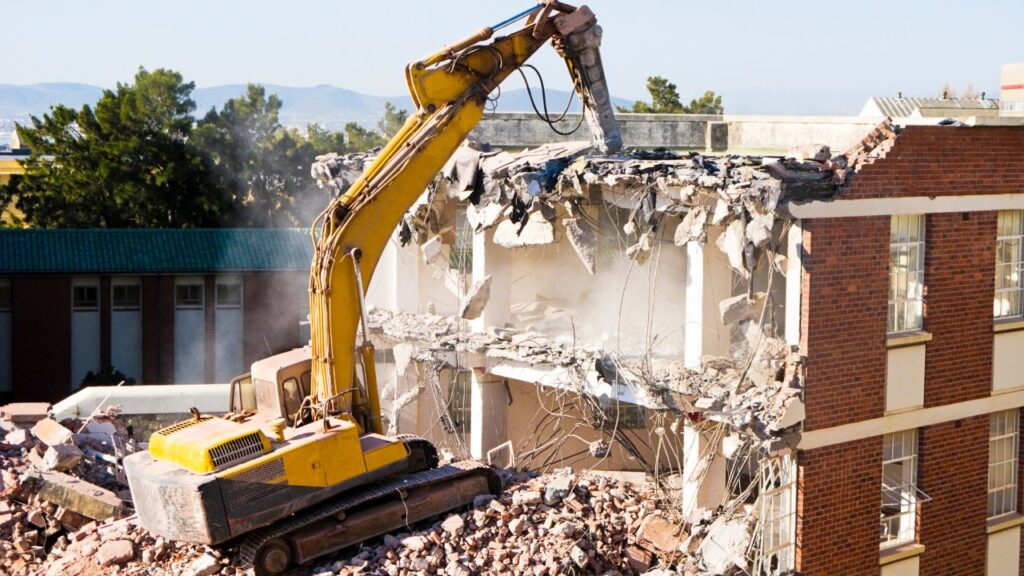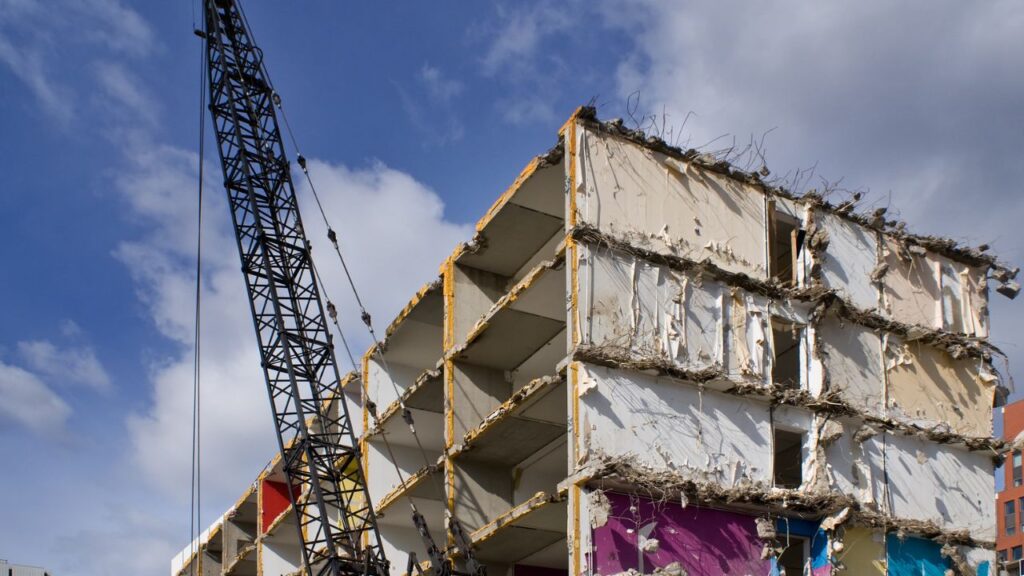Boost Your Demolition Bids – Request a Precision Estimate!
- Accurancy
- Efficiency
- Transparency
- Customization
- Time Saving
- Professionalism
- Cost Control

Demolishing a commercial property is a complex undertaking that requires meticulous planning, adherence to safety standards, and precise budgeting. One of the key elements in this process is understanding the demolition cost per square foot, as it provides valuable insights for budget estimation and resource allocation. In this article, we delve into the various factors influencing commercial demolition costs and explore the significance of accurate per-square-foot cost estimation.

In the realm of commercial demolition, the size and complexity of structures play a pivotal role in determining the overall cost of the demolition process. Larger commercial buildings, particularly those with intricate designs and multiple stories, necessitate more elaborate and intricate demolition procedures. The sheer scale of such structures demands a heightened level of attention, specialized equipment, and skilled labor, all of which contribute to an increase in overall demolition costs. Architectural intricacies and the presence of unique features further elevate the complexity, requiring careful planning and execution, thereby influencing the budgetary considerations for demolition projects.

Fully Insured Licensed Hire Contractor For Demolition
Hire Contractor
Make Informed Design Decisions Showcase Your Design Ideas
Get RenderingThe composition of materials used in the construction of commercial properties is a significant factor influencing demolition costs. The variety and nature of materials impact the methods and precautions required for their removal. The efficient removal and disposal of debris, a natural byproduct of the demolition process, often incur additional expenses. This is particularly true when hazardous materials are present, as their safe and compliant handling demands specialized procedures. Consequently, meticulous attention to the type of materials within the structure becomes essential during the cost estimation phase, ensuring an accurate projection of the expenses associated with their removal.
The selection of the appropriate demolition methodology is a critical decision that directly affects project costs. Different methods, such as mechanical demolition, deconstruction, or implosion, come with their own set of distinct costs and considerations. The choice of the demolition method hinges on various factors including the specific structure under consideration, environmental concerns, and the overarching goals of the project. Mechanical demolition involves systematic dismantling, deconstruction focuses on salvaging materials, while implosion requires careful planning. Each method presents its unique challenges, and the decision impacts the overall financial outlay for the commercial demolition endeavor.
The accessibility of the demolition site and the preparatory measures required significantly contribute to project costs. Commercial properties are often situated in diverse locations, and limited access to the site can necessitate additional efforts and resources to facilitate the entry and exit of demolition equipment. Comprehensive site preparation, involving the clearing of obstacles and ensuring a safe working environment, is integral to a smooth and efficient demolition process.

The extent of site clearing and any additional safety measures required can introduce variability in project costs, underscoring the importance of evaluating site accessibility during the cost estimation phase.
Environmental considerations constitute a crucial aspect of commercial demolition projects, introducing both ethical and financial dimensions. Strict compliance with environmental regulations and the identification of hazardous materials within the structure impose additional costs. Responsible handling and proper disposal of materials not only align with legal responsibilities but also contribute to sustainable and environmentally conscious practices. While such adherence may incur upfront expenses, the long-term benefits of minimizing environmental impact and fostering a positive public image are invaluable considerations in the overall cost estimation for commercial demolition.
Navigating the regulatory landscape and securing the necessary permits are indispensable steps in the commercial demolition process. The permitting requirements and associated fees can vary significantly based on the location of the property. Delays or fines due to non-compliance can have substantial implications for both the budget and timeline of the project. Therefore, a thorough understanding of local regulations, coupled with proactive measures to obtain the required permits, is essential for effective cost estimation and the overall success of the commercial demolition endeavor.
The cost per square foot is a valuable metric in commercial demolition as it provides a standardized measure for budgeting. Here are average cost ranges based on the chosen demolition method:

It’s crucial to note that these figures are general estimates, and actual costs may vary based on specific project requirements, site conditions, and regional differences.
Embarking on a commercial demolition project necessitates a meticulous examination of the property. This in-depth assessment goes beyond surface-level considerations, aiming to identify not only the structural aspects slated for demolition but also salvageable components. By pinpointing elements that can be repurposed or reused, stakeholders contribute to substantial cost savings. This approach aligns with sustainability goals and ensures that the demolition process is not only efficient but also environmentally responsible.

Opting for a selective or partial demolition strategy presents a nuanced and strategic approach to cost management. Rather than razing the entire structure, this method involves carefully dismantling specific components. This not only minimizes the volume of material requiring disposal but also opens avenues for salvaging valuable materials such as steel, concrete, or other components that can be repurposed. Beyond mere cost reduction, this approach fosters a sustainable outlook, contributing to both economic and environmental objectives.
Early detection and removal of hazardous materials stand as critical cost-saving measures in commercial demolition. Conducting comprehensive inspections at the outset of the project allows for the identification of materials such as asbestos or lead. By addressing these concerns proactively, project teams mitigate the risk of unexpected delays and additional costs during the demolition phase. Moreover, adhering to safety standards and environmental regulations from the project’s inception ensures a smooth progression, minimizing risks and associated expenses.
Efficient debris management is a fundamental aspect of commercial demolition cost savings. Implementing on-site sorting practices goes beyond mere waste reduction. It enables the identification of recyclable materials, reducing the volume of waste destined for landfills. Collaboration with recycling facilities may result in direct cost savings or even revenue for salvaged materials. An organized and thoughtful debris management plan not only contributes to cost efficiency but also aligns with sustainable waste management practices.
Choosing the right demolition technique is a pivotal decision that significantly influences cost-effectiveness and efficiency. Depending on the unique characteristics of the property, methods such as mechanical demolition, deconstruction, or implosion offer varying levels of savings in terms of time and resources. Tailoring the demolition approach to the specific nuances of the commercial property ensures optimal efficiency and cost-effectiveness. Collaboration with experienced demolition professionals further enhances the selection of techniques tailored to the project’s distinct requirements.
The integration of advanced technologies and modern demolition equipment marks a paradigm shift in precision and efficiency within the commercial demolition landscape. Utilizing cutting-edge equipment not only streamlines tasks but also reduces labor costs and overall project timelines. Embracing technology is not just a cost-saving strategy; it also enhances safety and accuracy during the demolition process. Staying abreast of the latest advancements in demolition technology allows for the incorporation of innovative solutions that optimize the overall cost-effectiveness of the project.
Strategic timing is a pivotal consideration in achieving cost savings in commercial demolition projects. Planning the project during periods of favorable economic conditions for construction and demolition services may lead to more competitive pricing from contractors. Understanding market dynamics and scheduling the demolition when demand for services is lower can result in cost efficiencies. Strategic timing aligns with budget considerations, ensuring that the project benefits from competitive pricing and optimized resource utilization. This proactive approach contributes to overall project success and cost savings.
Commercial property demolition demands careful planning and precise budgeting, with the cost per square foot being a crucial metric. Factors like building size, materials used, demolition method, site accessibility, and environmental considerations collectively influence costs.
The average cost ranges per square foot provide a baseline for budget estimates, but actual costs may vary. Strategies for cost savings include a detailed project assessment, selective demolition, early identification of hazardous materials, efficient debris management, optimized demolition techniques, technology integration, and strategic timing.
In conclusion, a well-informed and strategic approach, guided by accurate cost estimation, ensures a successful and cost-effective commercial demolition project.
The cost per square foot is determined by dividing the total demolition cost by the square footage of the commercial property. It provides a standardized measure for budgeting and resource allocation.
Various factors impact demolition costs, including building size and complexity, materials used, chosen demolition method, site accessibility, environmental considerations, and regulatory compliance.
The cost ranges serve as general estimates. Actual costs may vary based on project-specific requirements, site conditions, and regional differences. It is advisable to obtain detailed quotes for accurate budgeting.
A thorough examination helps identify salvageable components, allowing for strategic cost savings. Pinpointing elements that can be repurposed or reused aligns with sustainability goals and ensures an efficient and environmentally responsible demolition process.
Selective or partial demolition involves dismantling specific components rather than the entire structure. This strategic approach minimizes disposal costs, allows salvaging valuable materials, and fosters both economic and environmental objectives.
Early detection of hazardous materials, such as asbestos or lead, allows for proper planning and budgeting. Addressing these concerns proactively mitigates the risk of unexpected delays and additional costs during the demolition phase.
Utilizing advanced technologies and modern equipment enhances precision, reduces labor costs, and improves overall efficiency. Staying updated with the latest advancements allows for the incorporation of innovative solutions that optimize cost-effectiveness.
Planning the project during periods of favorable economic conditions may result in more competitive pricing from contractors. Strategic timing aligns with budget considerations, ensuring that the project benefits from optimized resource utilization and overall cost savings.
Here I am going to share some steps to get your commercial demolition cost per square foot estimate report.
You can send us your plan on info@estimatorflorida.com
Before starting your project, we send you a quote for your service. That quote will have detailed information about your project. Here you will get information about the size, difficulty, complexity and bid date when determining pricing.
Our team will takeoff and estimate your project. When we deliver you’ll receive a PDF and an Excel file of your estimate. We can also offer construction lead generation services for the jobs you’d like to pursue further.



561-530-2845
info@estimatorflorida.com
Address
5245 Wiles Rd Apt 3-102 St. Pete Beach, FL 33073 United States
561-530-2845
info@estimatorflorida.com
Address
5245 Wiles Rd Apt 3-102 St. Pete Beach, FL 33073 United States
All copyright © Reserved | Designed By V Marketing Media | Disclaimer